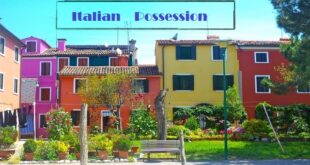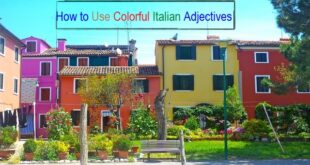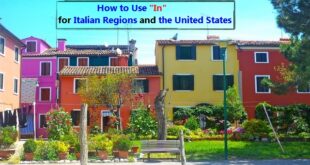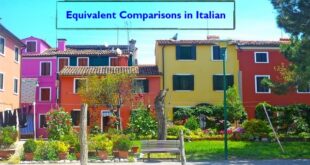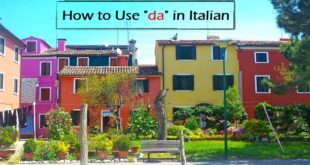Italian Possessive Adjectives for Things Possessive adjectives allow one to describe ownership. Did you know that to describe possession in English, we simply put a possessive adjective (my, your, his/hers, etc.) before a noun under discussion? The word placement is the same in Italian. But there are otherwise many differences in the English and Italian approach to describing our relationship to the things we own. In English, the possessive adjectives refer to the person who is the “owner” of the thing being talked about. However, the Italian use of possessive adjectives requires a different way of thinking, since Italians match …
Read More »Adding color with adjectives
To speak fluently in another language, it is important to know how to describe the characteristics of the people, places, and things that we encounter every day. Adjectives can enliven the listener’s perception of a subject and provide additional shades of meaning. In English, adjectives are generally placed before the noun. But in Italian, most adjectives are placed after the noun the modify, while a few groups of adjectives are placed before the noun. And finally, many Italian adjectives can hold either position in relation to their noun — either before or after. Interestingly, where an Italian adjective is placed in …
Read More »Getting there with “a” and “in”
Use the Italian “in” for Italian Regions Both Italian prepositions “a” and “in” can be used to describe where someone is going, as well as their destination when they arrive. The Italian “a” can be translated as both “to” or “in” in English. The Italian “in” is translated the same as in English — “in”! In simple terms, Italian prepositions are linked to the place that they describe. We’ve already learned the basics of how to use the Italian prepositions a and in in our first blog on this topic, Italian Preposition “A” or “In”? The general rule, stated again, …
Read More »Being polite with “volere”
The Italian Verb Volere Volere means “to want” or “to desire,” and is classified as a modal, or helping verb. This means that volere provides information about one’s wish or intention to complete the main action described in a sentence. When used in this way, volere is conjugated to reflect the speaker and the action verb follows directly after in its infinitive form — that is, the action verb is not conjugated! (Remember that Italian verbs are categorized into three infinitive forms by the following endings: -are, -ere, and -ire, and that English infinitive verbs are preceded by “to,” as in, …
Read More »An Italian Valentine’s Day
Over the centuries, writers have pondered the question, “Che cos’è l’amore?” “What is love?” And since the Italian poet Petrarch expressed his great love for Laura in the 14th century, love poems have often taken the form of he used — the sonetto, or sonnet. These “little songs” are 14 lines long and follow a specific rhythm and rhyme scheme. When Shakespeare took up the sonnet in the 16th Century, he changed Petrarch’s form and made it his own; Shakespeare used the sonnet to write some of the most famous lines about love in existence today. Shakespeare’s contemporaries and many poets who …
Read More »Equivalent Comparisons
Every day, we all compare the characteristics of one person, place or thing to another — and many times these characteristics are similar or the same. For instance, there are so many places in Italy that are beautiful, and one may be as beautiful as another! Or one place in Italy may have as many important sites of interest as another. In these cases, to make a comparison we must use the Italian adverbs come and tanto… quanto to relay the meanings “as,” “as well as,” and “as much as.” When comparing two different nouns — people, places, or things …
Read More »Mi Piace Natale
How to Say, “I like…” in Italian with “Mi Piace” In a previous blog on this topic, Using Piacere to say, “I like it!” we learned: The Italian verb piacere literally means “to be pleasing.” Italians use this verb when they want to express the idea that they like something. It is how Italians say, “I like it!” It should first be noted that piacere has an irregular conjugation. Then, it is important to understand that the verb piacere works differently than most other Italian verbs that have an -ere ending. In effect, the subject of the sentence that uses the verb piacere …
Read More »How to Use “Da” in Italian
Let’s continue our series about Italian prepositions with the essential Italian preposition “da.” The Italian preposition da can be translated into the English prepositions “from” and “by.” It serves as an essential link between Italian nouns, is used in Italian phrases that describe time in a complex way, and is also integral to many common expressions. If we learn how to use the Italian preposition da, we will truly sound like a native Italian! Use “Da” to Say Where You are From One of the most frequent questions asked during polite conversation is, “Where are you from?” We learned how to …
Read More »Being Polite with “Potere”
Potere means “to can” or “to be able to,” and is classified as a modal, or helping verb. This means that potere provides information about the ability of the speaker to “be able to” complete the main action described in a sentence. When used in this way, potere is conjugated to reflect the speaker and the action verb follows directly after in its infinitive form — that is, the action verb is not conjugated! (Remember that Italian verbs are categorized into three infinitive forms by the following endings: -are, -ere, and -ire, and that English infinitive verbs are preceded by …
Read More »Tag teaming two past tenses
Combining the Imperfetto with the Passato Prossimo Choosing an Italian Past Tense Let’s start our blog about how to combine the imperfetto with the passato prossimo by reviewing some general rules of Italian grammar. We learned in “Picking an Italian Past Tense” that the circumstances surrounding the event will determine which Italian past tense to use. Luckily, imbedded in many Italian sentences about past events are certain words and phrases that will indicate whether the imperfetto or the passato prossimo is needed. The intent of the speaker will be signaled by these phrases, which will then trigger use of the correct …
Read More » Fra Noi Embrace Your Inner Italian
Fra Noi Embrace Your Inner Italian

